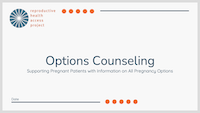Dec 17

Options Counseling
This presentation covers the basics in options counseling for unintended pregnancy.
Help Us Protect Access to Sexual and Reproductive Health Care Today!
Dec 17

This presentation covers the basics in options counseling for unintended pregnancy.
Dec 16

Written by Catherine Casado-Pabon, MD Body image and perception of weight gain influence both patients’ and clinicians’ contraception decision-making and counseling. Nearly half of women* using contraception will switch or discontinue their selected contraceptive method within the first year of use.1 While there are many reasons people discontinue or change their contraceptive method as needs…
Nov 25

Written by Julia Ellis-Kahana, MD and Mollie Nisen, MD Effective management of pain during uterine aspiration is critical for patient autonomy, satisfaction and safety.1 A patient’s experience of pain is influenced by a combination of distinct physical, emotional, and social factors. Therefore, a multimodal approach, guided by shared-decision making, and incorporating both nonpharmacologic and pharmacologic…
Nov 24

Written by Angeline Ti, MD, MPH Earlier this month, the World Health Organization (WHO) released the 6th edition of the Medical Eligibility Criteria for Contraceptive Use (MEC) and the 4th edition of the Selected Practice Recommendations for Contraceptive Use (SPR). Clinicians in the US may be familiar with the similarly named guidance, the US MEC…
Nov 18

The Affordable Care Act requires public and most private health insurance plans to cover the full range of birth control methods with no out-of-pocket costs. But some people do not have health insurance or have plans that are exempt from birth control coverage. This factsheet lists different resources and programs to help you obtain free or low-cost services so that cost does not have to limit access to your preferred birth control method.
Oct 29

A model for providing pregnancy options counseling to ambivalent patients.
Oct 28

Written by Evan Fu, PharmD Candidate 2025, and Regina Ginzburg, Pharm.D., CDCES, BC-ADM Opioid use has increased dramatically over the last two decades, including among people of reproductive age. The number of pregnant people with opioid use disorder (OUD) presenting to the hospital at labor and delivery quadrupled between 1999 and 2014.1 A recent data analysis…
Oct 28

This fact sheet explains how to use medication (misoprostol only) for an abortion with simple-to-follow steps and illustrations.
Oct 24

This fact sheet offers patients and clinicians a menu of options to manage pain during gynecologic procedures in an office setting, like IUD placement and removal, cervical or endometrial biopsies, colposcopy, uterine suction (e.g. abortion, miscarriage management), pap smears, and other common gynecologic care. Methods include: comfort options, non-steroidal anti-inflammatory drugs like ibuprofen and naproxen,…
Oct 24

Algorithm that visually outlines the options for managing an ongoing pregnancy or retained gestational sac on ultrasound after medication abortion.